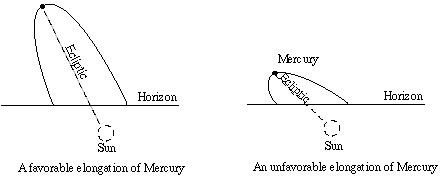
Observing Mercury
Mercury is the most difficult of the five planets known to the ancients to see. It is as bright as the bright stars, but, because its small orbit is inside the Earth's, it never gets more than two hours away from the Sun. Therefore, we usually see it in the dawn or evening twilight.
When Mercury is at greatest angular distance from the Sun as seen from Earth's point of view, it is said to be at greatest eastern elongation in the evening, or greatest western elongation in the morning. However, some elongations are more favorable than others. When the path of the planets, the ecliptic, is tilted more perpendicular to the horizon, Mercury can be higher in the sky. And because Mercury's orbit is the most elliptical of all the planets besides Pluto, sometimes the planet is actually further from the Sun than others. (To add to the complications, Mercury's orbit is tilted 7 degrees to the ecliptic, defined as the plane of the Earth's orbit.)

To find Mercury, pick a time within a few days of a favorable elongation and search the sky in the sunrise or sunset glow with binoculars about forty-five minutes to one and half hours before sunrise or after sunset. Mercury goes through phases like the Moon. (See diagram for Venus.) You may be able to see these in a telescope, but even this is difficult because Mercury is always close to the horizon (when visible) and the telescope has to peer through miles of atmospheric turbulance.
The most favorable elongation in the Fall of 1996 is September 16 when Mercury will appear as a morning star.
A unfavorable evening elongation occurs November 28, 1997.
Back to Observational Page